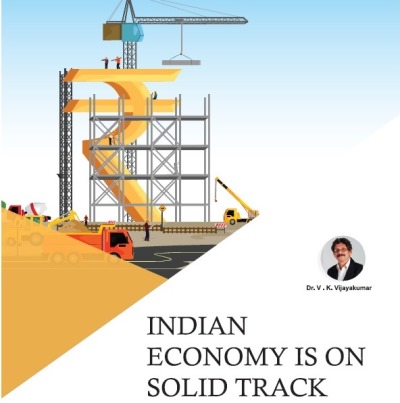By Dr. V.K.Vijayakumar
The present state of the Indian economy, the challenges that it faces and the measures to address these challenges are being discussed and hotly debated in the media these days. Healthy debate is eminently desirable. However, care has to be exercised in the use of various concepts of economics. If the concepts are interpreted wrongly and the facts are concealed, the debate becomes unhealthy and loses objectivity. Recently, many TV channels declared that, “India is in recession.” Some sections of media even gave breaking news: “The PM and FM admit to recession.” It is important to get the facts right.
Economics has a clear definition for recession. World over, students of economics are taught: “recession is a contraction of economic activity”. There are globally accepted norms for ‘global recession’ and ‘an economy in recession’. Global recession is when global GDP growth falls below 2 percent. When global GDP growth falls below 2 percent, there will be a contraction in global per capita GDP. This is the economic logic behind the 2 percent. In 2008 global GDP growth fell to 1.81percent landing the global economy in recession. In 2009, the situation worsened when the global GDP growth fell to -1.73 percent. Since this was the worst performance since the Great Depression of 1930s, this came to be known as the Great Recession. Emerging markets like India and China were unaffected by this Great Recession. That’s a different matter.
If we are to say that an economy is in recession, its GDP should contract; i.e., its GDP growth rate should become negative. The globally accepted norm is 2 quarters of negative GDP growth. For instance, in 2015 Brazil and Russia experienced negative GDP growth rates for 4 consecutive quarters. Again in 2016, Brazil experienced 4 quarters of negative GDP growth and Russia experienced 3 more quarters of negative GDP growth. In 2017, Saudi Arabia has experienced negative growth for 2 consecutive quarters. This is recession.
INDIA IS IN GROWTH SLOWDOWN, NOT IN RECESSION
India’s GDP growth fell to 5.7 percent in Q1 of FY 2018. It is a fact that the growth rate has been declining for 6 consecutive quarters. Of course, this is a matter of concern. But it is important to recognize that the Indian economy grew by 5.7 percent in the first quarter. This is one of the best growth rates in the world during this period. This slowdown is likely to be reversed in the coming quarters and we are likely to end this financial year with one of the highest growth rates in the world. In brief, what India is experiencing is a growth slowdown, not recession.
WHY IS GROWTH SLOWING DOWN?
GDP growth has 4 components: 1. Private consumption expenditure 2, Private Investment Expenditure 3, Govt expenditure and 4, Net exports. Of these 4 components, private consumption expenditure remains strong. Govt expenditure has increased substantially. Exports have been weak. The biggest drop is in private investment expenditure. So, private investment expenditure is the main culprit in this growth slowdown. The question, therefore, is: why has private investment dropped hugely? This needs explanation.
During 2003-2011, India’s GDP grew by 8.4 percent. The 2008-09 recession didn’t impact India much. After a brief slowdown in 2008, India staged a ‘V’ shaped recovery. During 2006-10, private investment in India increased hugely. Massive capacity was created by private sector, particularly in sectors like steel, power etc. Major part of this capacity creation was financed by bank credit. (This later created the problem of what CEA Arvind Subramaniam called “the twin balance sheet issue”: the overleveraged companies and the highly stressed banking system with huge NPAs.) The quick turn-around of the Indian economy from the global recession created an impression that Indian economy has disconnected from the global slump and that India’s high growth rate will be sustained for many years. It was this over confidence that led to this huge capacity creation during 2006-10.
But the situation did not turn out as expected. The lagged effect of the global recession, the European debt crisis of 2010-11, the EM currency crisis of 2013 and the commodity crash of 2014 impacted global growth and global trade. Global trade slumped; India’s exports were impacted. Decline in exports impacted India’s growth too.
Growth deceleration during the last 6 quarters is primarily due to the slack in private investment. The main reason for poor private investment is the low level of capacity utilization in manufacturing. If capacity utilization is around 70 percent, investment will not happen. Presently capacity utilization has improved to 74 percent from 70 percent. Normally, investment starts picking up when capacity utilization reaches around 80 percent. Perhaps, this might take a few more quarters.
Of course, demonetization aggravated the slowdown. The informal sector was impacted hugely, adversely affecting growth and employment. But with remonetization, that problem does not exist now. Presently, GST related disruption is impacting growth. GST impacts the informal sector much more seriously than the temporary impact of demonetization.
GST IS A MAJOR STRUCTURAL REFORM
It is important to appreciate the fact that GST is a major structural reform. It will have short-term disruptions; but the long-term beneficial impact will be huge. GST will bring about formalization of the economy with excellent long-term benefits. Critics of demonetization and GST, who emphasize the hit on the informal sector, miss an important point. The informal sector in India thrived on massive tax evasion. Major chunk of the informal sector evaded indirect taxes and profited. Since their business transactions were not captured in the tax system, they evaded direct taxes too. The cost to the economy from this massive tax evasion has been huge.
GST will impact the informal sector in two ways. The very small enterprises will not be impacted since they are exempt. The segment that thrived on tax arbitrage will find the going tough and cede market share to the organized sector. The other segment will be forced to become compliant and will become part of the formal sector. The long-term consequence of this transition will be huge revenue buoyancy, which will enable the government to spend more money on welfare schemes for the poor and massive infrastructure push.
THE MEGA PSU BANK RECAPITALIZATION DRIVE
The twin balance sheet issue referred earlier impacted credit growth and became a major drag on economic growth. On 24th October the government took the bold decision to recapitalize the PSU banks by infusing Rs 2.21 lakh crores, of which Rs 1.35 lakh crores will be through bonds, the details of which are to be announced later. On 25th October the PSU bank index gained a phenomenal 29%. Along with this mega bank recapitalization initiative, the government also announced infrastructure push of Rs 7 lakh crores with the Bharathmala project to construct 20000 km of highways. These two measures will certainly help accelerate growth, going forward.
STRONG REBOUND IN GROWTH IMMINENT
There are enough leading indicators that are signaling economic recovery in the coming quarters. For instance, automobile sale, which is regarded as a significant leading indicator, is picking up strongly. Particularly, the sale of commercial vehicles, an indicator of economic activity, has grown impressively by 27 percent in August and 26 percent in September. Another major positive indicator is the turn around in exports, which have recovered to 10.29 percent in August from 3.94 percent in July and 3.4 percent in June. In September exports surprised even the optimists with a blistering growth of 25.6 percent. These are clear signals of strong economic recovery, which will be captured in the GDP growth in the coming quarters.
THE RESETS FOR A CLEANER INDIA
The reforms under way in India have the potential to usher a new and cleaner India. DBT, GST, RERA, Benami Act and the Bankruptcy Code have the potential to transform India for the better. There is a consensus among global think tanks today that India can return to fast growth and sustain that growth for many years.
The latest IMF Report projects GDP growth of 6.7 percent for India for FY2018. The report also says that in 2018-19 India will reemerge as the fastest growing large economy in the world with growth rate of 7.4 percent. This is the most likely scenario. Therefore, talks of recession, depression, tailspin etc. are likely to be short lived. As a leading indicator, the stock market is discounting this expected recovery in growth and earnings.










